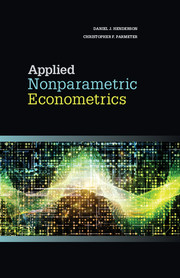Book contents
- Frontmatter
- Dedication
- Contents
- 1 Introduction
- 2 Univariate density estimation
- 3 Multivariate density estimation
- 4 Inference about the density
- 5 Regression
- 6 Testing in regression
- 7 Smoothing discrete variables
- 8 Regression with discrete covariates
- 9 Semiparametric methods
- 10 Instrumental variables
- 11 Panel data
- 12 Constrained estimation and inference
- Bibliography
- Index
11 - Panel data
Published online by Cambridge University Press: 05 February 2015
- Frontmatter
- Dedication
- Contents
- 1 Introduction
- 2 Univariate density estimation
- 3 Multivariate density estimation
- 4 Inference about the density
- 5 Regression
- 6 Testing in regression
- 7 Smoothing discrete variables
- 8 Regression with discrete covariates
- 9 Semiparametric methods
- 10 Instrumental variables
- 11 Panel data
- 12 Constrained estimation and inference
- Bibliography
- Index
Summary
Nonparametric estimation of panel-data models are becoming increasingly popular in the literature. Most of the earlier methods were developed by statisticians and focused on random-effects-type estimators (e.g., Lin and Carroll, 2001). These methods are valid when the individual specific effects are uncorrelated with the regressors. This assumption is generally violated with economic data. More recent work allows for correlation between the individual specific effects and the regressors (e.g., Henderson, Carroll, and Li, 2008; Qian and Wang, 2012). These fixed-effects estimators are more difficult to implement, as is the case with parametric nonlinear panel-data models, as taking a simple first difference or averaging over time and differencing does not lead to a parsimonious model.
In this chapter, we outline several existing fixed and random effects nonparametric estimators. We pay special attention here to the rate of convergence of the estimators as well as how incorporating the variance–covariance structure affects estimation. An unexpected result of the current crop of these estimators is that incorporation of the variance–covariance matrix often leads to no asymptotic improvement. This result often occurs because, as we have explained previously, as the sample size increases, the bandwidth decrease towards zero. Therefore as we have larger samples, we end up using a smaller neighborhood of data around the point, mitigating the ability of the exploitation of the variance–covariance structure to improve estimation efficiency. Recent research has successfully overcome this issue (e.g., Yang, 2013; Yao and Li, 2013).
As with each estimator in our book, we discuss bandwidth selection. Here we discuss cross-validation methods which are unique to panel data. The same holds true for bootstrap methods in order to calculate standard errors and perform tests. We consider tests for poolability, correct functional form specification, and a nonparametric Hausman test.
In most of this chapter we discuss one-way error component models, primarily focusing our discussion on controlling for individual effects. It is possible to also estimate models, controlling for both individual and time effects.
- Type
- Chapter
- Information
- Applied Nonparametric Econometrics , pp. 293 - 320Publisher: Cambridge University PressPrint publication year: 2015



